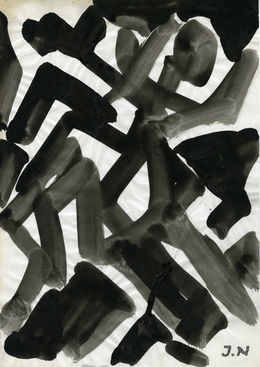
JACQUES NESTLÉ
Sarrebruck 1907 - Paris 1991
“Je ne suis ni un peintre ni un artist; je suis simplement un home qui peint. "
"I am neither a painter nor an artist ; I am simply a man who paints.”
This statement, in itself, could well summarize the life and work of Jacques Nestle. Born in 1907 in Sarrebruck, a region bordering France, to a father of Neapolitan origin and a mother of German-French origin, Nestle was a fruit of a triple culture.
Interested in an artistic career, he left Sarrebruck in 1923, at the age of sixteen for the artistic turmoil of Paris, where he found work at a lithography print shop. It was there that he met a group of artists, among them, Henri Matisse, who saw his drawings and encouraged and instructed him. Soon he found a job as an interior designer and architect of interior spaces, which assured his subsistence. But his unique reason to remain in Paris was to paint.
Two other prominent artists of the period, Pond and Kahnweiler saw Nestle’s work, were impressed, and encouraged him. Kahnweiler expressed a keen interest in Nestle’s work and wanted to promote it, but Nestle turned him down, sealing his destiny as a largely unrecognized artist in the public eye and a jealous custodian of his works.
Nestle left Paris for Berlin in 1925, fascinated by the Berlin Secession artistic movement. From post-cubism to geometric abstraction, these years helped form his work in the artistic effervescence of the Bauhaus Movement and established the avant-garde trademark of his work. He exhibited during these years in the Berliner Secession.
A militant anti-Nazi, he left Germany in 1933 and returned to Paris, bringing with him some rolled canvases, etchings and wood cuts, the only evidence of this époque.
The period after the war marked his return to geometric abstractions and by age 50, his art evoked an ambiguity between figurative and abstract forms. In full mastery of his art, he used the fluidity of gouache and china ink to express himself in his large compositions on paper.
His work from the 30s, 40s, 50s and 60s, insolent and impertinent, denotes a painter whose work evokes an authenticity in form of the greatest artists of the period: Pond in front of the bare bodies of his women, Picasso with his twisting faces, or of Miro and Kandinski with their large canvases, where the eye is dominated by the blues, grays, and black luminosity. His rich abstracted form speaks to us without manners. It is simply authentic. Such is the deep nature of his work.
Nestle summarized his work by saying that his work shows itself to be conceived in a creative instant, where he was seized by an irrepressible craving to paint, without knowing why. Failing to exhibit or promote himself while alive, he has bequeathed us an extraordinary collection of work which is now being recognized, as extremely important.
Recent exhibitions include Berlin, 2009 and Paris November, 2011.
























